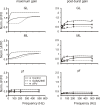High-Pass Filtering and Dynamic Gain Regulation Enhance Vertical Bursts Transmission along the Mossy Fiber Pathway of Cerebellum
- PMID: 20577586
- PMCID: PMC2889686
- DOI: 10.3389/fncel.2010.00014
High-Pass Filtering and Dynamic Gain Regulation Enhance Vertical Bursts Transmission along the Mossy Fiber Pathway of Cerebellum
Abstract
Signal elaboration in the cerebellum mossy fiber input pathway presents controversial aspects, especially concerning gain regulation and the spot-like (rather than beam-like) appearance of granular to molecular layer transmission. By using voltage-sensitive dye imaging in rat cerebellar slices (Mapelli et al., 2010), we found that mossy fiber bursts optimally excited the granular layer above approximately 50 Hz and the overlaying molecular layer above approximately 100 Hz, thus generating a cascade of high-pass filters. NMDA receptors enhanced transmission in the granular, while GABA-A receptors depressed transmission in both the granular and molecular layer. Burst transmission gain was controlled through a dynamic frequency-dependent involvement of these receptors. Moreover, while high-frequency transmission was enhanced along vertical lines connecting the granular to molecular layer, no high-frequency enhancement was observed along the parallel fiber axis in the molecular layer. This was probably due to the stronger effect of Purkinje cell GABA-A receptor-mediated inhibition occurring along the parallel fibers than along the granule cell axon ascending branch. The consequent amplification of burst responses along vertical transmission lines could explain the spot-like activation of Purkinje cells observed following punctuate stimulation in vivo.
Keywords: GABA-A receptors; NMDA receptors; cerebellum; gain control; imaging; voltage-sensitive dye.
Figures








Similar articles
-
A realistic large-scale model of the cerebellum granular layer predicts circuit spatio-temporal filtering properties.Front Cell Neurosci. 2010 May 14;4:12. doi: 10.3389/fncel.2010.00012. eCollection 2010. Front Cell Neurosci. 2010. PMID: 20508743 Free PMC article.
-
Synchronization of golgi and granule cell firing in a detailed network model of the cerebellar granule cell layer.J Neurophysiol. 1998 Nov;80(5):2521-37. doi: 10.1152/jn.1998.80.5.2521. J Neurophysiol. 1998. PMID: 9819260
-
Hebbian Spike-Timing Dependent Plasticity at the Cerebellar Input Stage.J Neurosci. 2017 Mar 15;37(11):2809-2823. doi: 10.1523/JNEUROSCI.2079-16.2016. Epub 2017 Feb 10. J Neurosci. 2017. PMID: 28188217 Free PMC article.
-
The cerebellar Golgi cell and spatiotemporal organization of granular layer activity.Front Neural Circuits. 2013 May 17;7:93. doi: 10.3389/fncir.2013.00093. eCollection 2013. Front Neural Circuits. 2013. PMID: 23730271 Free PMC article. Review.
-
The cerebellar network: from structure to function and dynamics.Brain Res Rev. 2011 Jan 7;66(1-2):5-15. doi: 10.1016/j.brainresrev.2010.10.002. Epub 2010 Oct 13. Brain Res Rev. 2011. PMID: 20950649 Review.
Cited by
-
An excitatory GABA loop operating in vivo.Front Cell Neurosci. 2015 Jul 16;9:275. doi: 10.3389/fncel.2015.00275. eCollection 2015. Front Cell Neurosci. 2015. PMID: 26236197 Free PMC article.
-
Integration and regulation of glomerular inhibition in the cerebellar granular layer circuit.Front Cell Neurosci. 2014 Feb 25;8:55. doi: 10.3389/fncel.2014.00055. eCollection 2014. Front Cell Neurosci. 2014. PMID: 24616663 Free PMC article. Review.
-
Retina-Inspired Organic Heterojunction-Based Optoelectronic Synapses for Artificial Visual Systems.Research (Wash D C). 2021 Feb 22;2021:7131895. doi: 10.34133/2021/7131895. eCollection 2021. Research (Wash D C). 2021. PMID: 33709082 Free PMC article.
-
Synaptic glutamate spillover increases NMDA receptor reliability at the cerebellar glomerulus.J Theor Biol. 2011 Nov 21;289:217-24. doi: 10.1016/j.jtbi.2011.08.018. Epub 2011 Aug 23. J Theor Biol. 2011. PMID: 21884708 Free PMC article.
-
Granular layEr Simulator: Design and Multi-GPU Simulation of the Cerebellar Granular Layer.Front Comput Neurosci. 2021 Mar 16;15:630795. doi: 10.3389/fncom.2021.630795. eCollection 2021. Front Comput Neurosci. 2021. PMID: 33833674 Free PMC article.
References
-
- Albus J. S. (1971). A theory of cerebellar function. Math. Biosci. 10, 25–6110.1016/0025-5564(71)90051-4 - DOI
-
- Bower J. M., Woolston D. C. (1983). Congruence of spatial organization of tactile projections to granule cell and Purkinje cell layers of cerebellar hemispheres of the albino rat: vertical organization of cerebellar cortex. J. Neurophysiol. 49, 745–766 - PubMed
LinkOut - more resources
Full Text Sources

